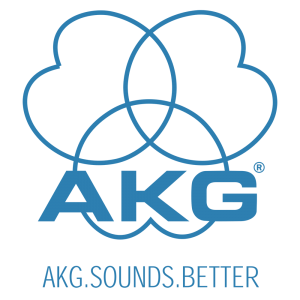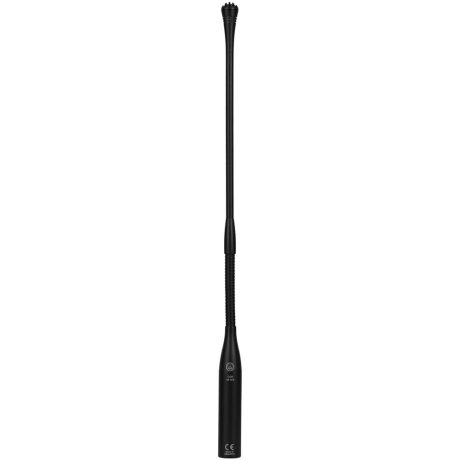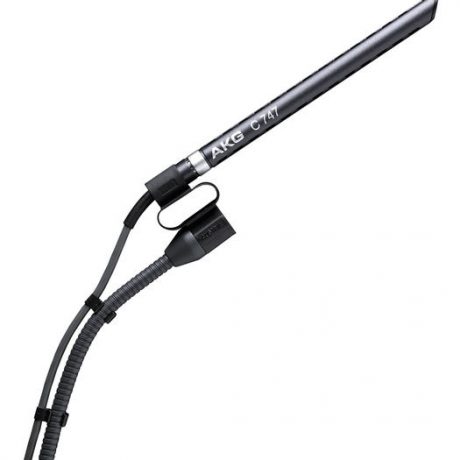| Content |
- Hypercardioid polar pattern
- 38 cm long
- 95° pickup angle
- For acoustically difficult environments
- Connects easily via XLR connector
The hypercardioid polar pattern with its narrow 95° pickup angle is suited best for situations where noise typically occurs from all sides (particularly in worship centers), where people talk into the microphone from a greater distance, or where several talkers are grouped side by side. Two different lengths are available. The .exible joint ensures optimum alignment of the gooseneck to any talker position. Several options are available for installation, i.e., stand, tabletop installation, and lockable.
Choosing polar patterns
Selecting the correct polar pattern for installed sound is difficult since it depends on a variety of factors. Of course the acoustics of the room play a key role. For highly reverberant rooms such as worship centers, a hypercardioid polar pattern will be the best choice to avoid high levels of unwanted noise. Correct placement of the loudspeakers is also essential. If the speakers project right at the capsule, a hypercardioid will be your best bet. The most difficult task, however, is trying to judge how the talkers will behave. For talkers who are inexperienced or move around a lot, be sure to choose a cardioid polar pattern for reliable pickup; talkers at a greater distance from the mic will be served best by a hypercardioid.
The microphone shall be a hypercardioid gooseneck microphone. Its pickup angle shall be 95 degrees; frequency range 50 Hz to 19 kHz; sensitivity 12 mV/Pa; max. SPL 125 dB; electrical impedance
| Polar pattern |
Hypercardioid |
| Frequency range |
50 to 19,000 Hz |
| Sensitivity |
12 mV/PA = -38 dBV re 1 V/Pa |
| Max. SPL |
125 dB (for 1% THD) |
| Equivalent noise level |
|
| Signal/noise ratio (A-weighted) |
>73 dB |
| Impedance |
=2,000 ohms |
| Supply voltage |
English: 9 to 52 V phantom power to IEC 61938 (DPA adapter integrated) |
| Powering |
|
| Connector |
3-pin male XLR |
| Finish |
matte black |
| Dimensions |
CGN 99 H/S: 13.5 x 380 mm (0.5 x 15 in.);
CGN 99 H/L: 13.5 x 580 mm (0.5 x 23 in.) |
| Net weight |
CGN 99 H/S: 480 g (17 oz.);
CGN 99 H/L: 500 g (17.7 oz.) |
|
Designed for Broadcast, House of Worship, Pro Music, and other applications.
Half-cardioid polar pattern
Boundary layer
Ultra-thin profile (16 mm) housing
Rubber non-slip bottom pad and strong steel screen
Integrated pop filter
Case Material Die cast zinc
Connector Type 3-pin XLR
Element Back Electret Condenser
Finish Non-reflecting Black
Finish White
Impedance, Low-Z balanced 200 Ω
Mic Type Boundary
Open Circuit Voltage 25 mV/Pascal
Polar Pattern Cardioid
Wired/Wireless Wired
Height 16 mm (0.63“)
Width 94 mm (3.7“)
Depth 123 mm (4.84“)
Weight Net 12.63 oz (358 g) |
- Immune to RF interference
- Speech optimized frequency range
- Enhanced hypercardioid polar pattern
- High SPL capability
- Premium microphone for ubiquitous application
A History of Sound: The C 747, the so called „pencil microphone“, was first built in 1987. Due to its excellent technical specifications, especially the wide and flat frequency range, it was used for the recording of all kinds of musical instruments, even those with very low frequencies. Because of its brilliant sound reproduction and its inconspicuous optical appearance, it was quickly known as an ideal overhead microphone.
Thank to the narrow polar pattern it solved the crosstalk problem (when recording multiple instruments at once) and the problem of picking up sounds from distant spots in a room. But for all that, due to the help of the acoustically well balanced, short interference tube, it didnʼt face one of the biggest problems of most shotgun microphones – the change of the polar pattern over the frequency. This is one of many reasons why this microphone found its way into a great number of Broadcast Stations, Recording Studios, Theatres, Opera Houses, Churches, Conference Rooms and Lecture Halls.
Another big advantage of the C 747 is that the microphone will not change the sound or level too much even when the person speaking is moving a lot. So it came that the C 747 finally found its way into installed sound systems as a perfect speech and lectern microphone. The C 747 is now one of the most versatile microphones in the AKG product range and over the years it has been available in various versions and model types such as hanging module, capsule for modular gooseneck microphones and in a boundary layer microphone.
Whatʼs New in V11: As it is more and more used in conference applications, we carefully redesigned the C 747 to better cope with some specific installed sound issues.
The new C 747 V11 will have an integrated RFi shield to block out unwanted interference by mobile phones, wireless mics and the like. Also we have fine tuned the frequency response to give especially the spoken word an outstanding presence, without changing the flavour of the classic C 747 sound.
An enhanced polar pattern provides consistent off-axis rejection to control ambient noise and feedback in acoustically difficult environments. This makes the C 747 V11 an excellent choice for noisy discussion groups or reverberant pulpits while it is forgiving enough to clearly pick up talkers moving around in front of the microphone. A switchable LF roll-off filter suppresses mechanical noise. The low-impedance transformerless preamp operates on 9 to 52 V phantom power.
The C 747 V11 ships with an extensive accessory set including a shock mount/adapter, mini gooseneck, stand adapter, mounting clamp, thread link, and windscreen.
SPECIFICATIONS:
| Polar pattern | hypercardioid | | Frequency range | 30 to 18,000 Hz | | Sensitivity | 8.5 mV/Pa (-42 dBV) | | Max. SPL | 133 dB | | Equivalent noise level (IEC 60268-4) | 32 dB | | Equivalent noise level | 21 dB-A | | Signal/noise ratio (A-weighted) | 73 dB | | Bass filter | 12 dB/octave at 150 Hz | | Impedance | 400 ohms | | Recommended load impedance | >1500 ohms | | Supply voltage | 9 to 52 V phantom power to DIN 45596 | | Powering | |
|
Recommended For:
- Brass
- Drums
- Percussions
- Woodwinds
Features:
- Miniature condenser clip-on microphone for wind instruments, drums, and percussions
- Miniature gooseneck for accurate microphone alignment
- Including wireless direct adapter for easy use with AKG pocket transmitters
- Detachable microphone cable
- Transducer shock mount for high mechanical-noise rejection
Standard Accessories:
- A400 adapter
- Microphone bag
- W44 Windscreen
Specs:
- Polar pattern cardioid
- Frequency range 60 Hz to 20 kHz
- Sensitivity 5 mV/Pa (-46 dBV)
- Max. SPL 130/132 dB SPL (for 1 %/3 % THD)
- Equivalent noise level 31 dB(A)
- Signal/noise ratio (A-weighted) 63 dB
- Impedance = 2000 ohms
- Current consumption
|
Features:
- Miniature cardioid condenser clamp-on microphone with shock mounted capsule
- Ideal for miking drums and percussions
- Including wireless direct adapter for easy use with AKG pocket transmitters
- Detachable microphone cable
- Integrated gooseneck
- Continuously adjustable vise type clamp
Recommended For:
- Drums
- Brass
- Recording
- Percussions
Standard Accessories:
- A400 adapter
- H518 Drum bracket
- Microphone bag
- W44 Windscreen
Specs:
- Polar pattern cardioid
- Frequency range 60 Hz to 20 kHz
- Sensitivity 5 mV/Pa (-46 dBV)
- Max. SPL 130/132 dB SPL (for 1%/3% THD)
- Equivalent noise level 31 dB(A)
- Signal/noise ratio (A-weighted) 63 dB
- Impedance = 2000 ohms
- Current consumption
|
- Cardioid polar pattern
- 10 m (33 ft.) cable
- 125° pickup angle
- Especially suited for choir recordings
- Integrated spring steel clamp for optimum alignment
The new CHM 99 Condenser Hanging Microphone provides both ease of use and a high level of functionality. There is hardly any more affordable and simpler solution for recording choirs at worship centers. Suspended from the ceiling or a beam, the hanging microphone is aligned and then fixed in the correct position. Now use the spring steel clamp to adjust the correct angle, and off you go!
The CHM 99 is available in white or black.
XY stereo recording
Using two CHM 99 hanging microphones in an XY configuration (coincident pair) is a good way to make stereo recordings, particularly of choirs. However, sound source locations are defined only by intensity differences. Adjusting the angle between the microphones determines the width and depth of the stereo image.
ORTF stereo recording
Developed by the French Broadcasting Authority, this technique differs from the XY technique by recording not only intensity differences, but also delay differences. The capsules are aligned at an angle of precisely 110° and 170 mm / 6.7 in. apart.
Polar pattern Cardioid
Frequency range 70 to 18,000 Hz
Sensitivity 18 mV/PA = -35 dBV re 1 V/Pa
Max. SPL 125 dB (for 1% THD)
Equivalent noise level 73 dB
Impedance =2,000 ohms
Supply voltage 9 to 52 V phantom power to IEC 61938 (DPA adapter integrated)
Powering |

















Reviews
There are no reviews yet.